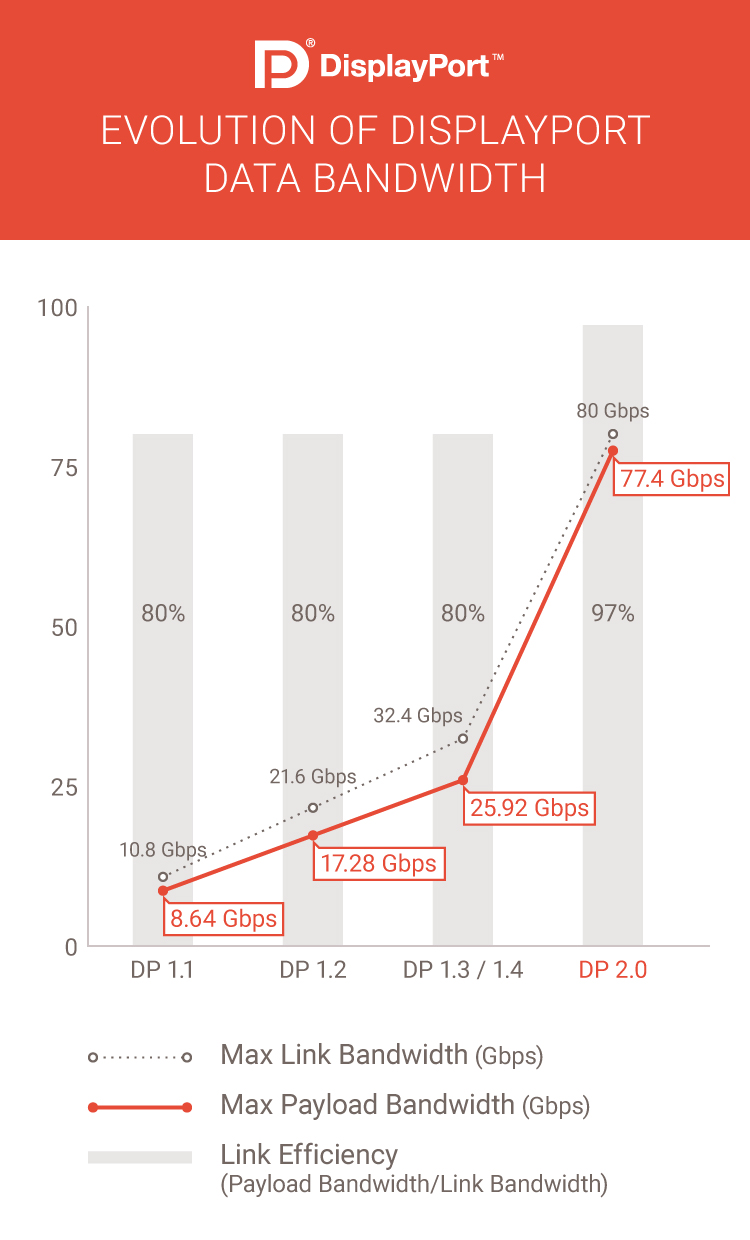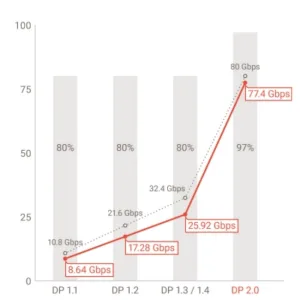Last Monday, the Video Electronics Standards Association (VESA) held a press briefing on the latest iteration of DisplayPort, version 2.0.

Display interfacing standards remain both a fascination and pet peeve for me; the former because the bandwidth limits of what copper can carry continue to be stretched, and the latter because display interfaces are, more often than not, the “choke point” for moving images with high dynamic range, wider color gamuts, and faster frame rates.
First, some history. Ever since the Digital Visual Interface (DVI) made an appearance in 1999, transition-minimized differential signaling (TMDS) has dominated the display interface market. DVI, which never supported audio and was intended as a computer interface, was supplanted in 2002 by the High Definition Multimedia Interface (HDMI), which did support embedded audio.
HDMI largely had the playing field to itself until 2006, when VESA announced a brand-new, packet-based display interface, DisplayPort (DP). The first DP chipsets showed up two years later, by which time HDMI was already at version 1.3 and had established itself as the standard for consumer electronics (television, DVD, Blu-ray, AV receivers, set-top boxes, etc.)
What’s interesting is that, while HDMI had a maximum data rate of 10.2 Gb/s at that point, DisplayPort 1.2 had already reached 21.4 Gb/s, adding some degree of future-proofing. Indeed, Mini DisplayPort became the preferred interface for Apple laptop computers partly for that reason.
Things remained relatively quiet until the introduction of Ultra HDTV displays in 2012 started an interface speed race that continues to this day. The HDMI Forum responded to Ultra HD with version 2.0 in September of 2013 (TMDS, 18 Gb/s) and VESA returned serve with DP 1.3 a year later (packet, 32.4 Gb/s or 8.1 Gb/s per lane).
The rapid adoption of Ultra HDTVs by consumers and the introduction of high dynamic range prompted the announcement of DisplayPort 1.4 in 2016, primarily to support HDR metadata and 4:2:0 and 4:2:0 color modes, along with Display Stream Compression (DSC). And that volley was returned with a strong forehand shot, HDMI 2.1, which finally abandoned TMDS for an all-digital packet design in 2017, boosting the bandwidth ceiling to 48 Gb/s (12 Gb/s per lane).
Match point? Hardly. VESA held serve, and has now officially unveiled DisplayPort 2.0, which claims an astronomical boost in speed to 77.4 Gb/s across all four lanes, just shy of 20 Gb/s per lane – about where Thunderbolt 3 is now. VESA has also designated three Ultra High Bit Rate (UHBR) modes for the interface: UHBR-10 (10 Gb/s per lane), UHBR-13.5 (13.5 Gb/s per lane), and HBR-20 (20 Gb/s per lane).
That’s quite a jump in speed. How’d they do it? One solution is to hack away at the customary 20% bit overhead common to HDMI and DisplayPort. HDMI 2.1 did it by switching from 8-bit/10-bit coding to 16b/18b, reducing their bit overhead to an impressive 11%. Now, DP 2.0 goes even further by using 128b/132b coding, cutting the bit overhead to a miniscule 3%.
This also allows VESA to claim DP 2.0 will pass 8K/60 10-bit 4:4:4 (RGB) @ 60 Hz display signals at full bandwidth…which, with 128b/132b coding, would require an uncompressed bit rate of 73.42 Gb/s, as opposed to 85.5 Gb/s using the traditional 20% bit overhead.
DP 2.0 is green, too! From the press release: “DP 2.0 also supports VESA’s new Panel Replay capability…Similar to the Panel Self Refresh capability in Embedded DisplayPort (eDP), Panel Replay incorporates a partial update feature that enables the system video processor, or GPU, to update only the portion of the display that has changed since the video frame update, thus saving system power. Advantages include the ability to recharge a device more quickly while at the same time using it.”
DP’s USB Type-C Alternate Mode also gets a boost. “When using only two lanes on the USB-C connector via DP Alt Mode to allow for simultaneous SuperSpeed USB data and video, DP 2.0 can enable such configurations as:
- Three 4K (3840×2160) displays @144Hz and 30 bpp 4:4:4 HDR (with DSC)
- Two 4Kx4K (4096×4096) displays @120Hz and 30 bpp 4:4:4 HDR (with DSC)
- Three QHD (2560×1440) @120Hz and 24 bpp 4:4:4 (no compression)
- One 8K (7680×4320) display @30Hz and 30 bpp 4:4:4 HDR (no compression)”
Okay, no more math, I promise! We handful of analysts that actually pay attention to this nuts-and-bolts stuff continue to scratch our heads with each of these “citius, altius, fortius” press announcements that remain “on paper” specifications for now. The television marketplace isn’t interested in adding anything to the cost of their low-margin products, even if it would make a noticeable improvement. It doesn’t help that this crowd has historically regarded DP as “that computer interface,” keeping their distance.
Even computer manufacturers seem to leaning more toward HDMI. Dell’s Precision M5520 (15.6” screen and a gaming favorite, the MSI GS7 Stealth 3014 (17” screen) both have native Ultra HD LCD screens and fast CPUs and video cards. But both are limited to 2160p/60 8-bit RGB external display connections because they use HDMI 2.0, and not DisplayPort 2.1. Why? Gamers want to connect them to 65-inch and larger Ultra HDTVs, that’s why.
Amazingly, DP 1.2 is still in use a decade later as just a handful of companies support DP 1.3. I don’t know of any manufacturer who employs DP v1.4 or DSC, although the latter is now the basis of the Blue River NT system being pushed for AV-over-IT (SDVoE) in the commercial audiovisual space.
So, what to make of VESA’s announcement? Hmm…check back with us in about five years…


